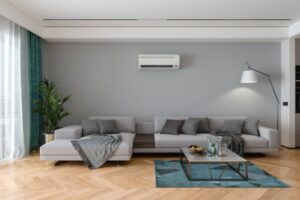Reverse-cycle air conditioning heats and cools your home with the flick of a switch. This type of climatic control system is an effective way to reduce energy consumption.
 Reverse-cycle split systems have advanced inverter technology that allows them to adapt to your room’s temperature. Some also feature an air-purifying filter that captures dust, smoke and harmful bacteria. This is useful for people with allergies, hay fever and asthma. For more information about reverse cycle air conditioning, check this out.
Reverse-cycle split systems have advanced inverter technology that allows them to adapt to your room’s temperature. Some also feature an air-purifying filter that captures dust, smoke and harmful bacteria. This is useful for people with allergies, hay fever and asthma. For more information about reverse cycle air conditioning, check this out.
Cost-effectiveness
Reverse cycle air conditioning is a cost-effective way to heat your home in winter and cool it in summer. It uses electricity rather than gas fuel heaters to heat your home and can be a good choice for households with children or pets. It also helps to control dust vermin in your home and can purify the air.
While reverse-cycle systems can save you money on energy costs, ensuring your system is sized correctly is essential. An onsite survey conducted by an expert can help you determine the ideal size of your unit. If your air conditioner is too large for your home, it will be overpowered and decline in efficiency. Conversely, if it is too small for your home, it will be inefficient and waste energy.
Energy efficiency
One of the main benefits of a reverse-cycle air conditioning system is its energy efficiency. It uses far less electricity than separate heating and cooling systems, which results in significant cost savings on your power bills.
Reverse-cycle air conditioners use less energy because they only create hot air by absorbing heat from the air outside your home. This is much more efficient than traditional electric heaters, which burn fuel to generate their heat. For more information about reverse cycle air conditioning, check this out.
Moreover, you can control your energy usage with a reverse-cycle air conditioning unit, which will help you save even more money. Invest in quality insulation to reduce your energy consumption and get a system with a high star rating to ensure maximum efficiency.
Hiring a professional to install your air conditioning is also a good idea. They can provide expert advice and assistance, ensuring that your new system meets all your requirements.
Hygiene
Reverse-cycle air conditioning systems offer both cooling and heating. They use the refrigeration cycle to cool your home, then reverse it to warm it. The refrigerant passes through the external coil, absorbing heat from the air and passing it back to the inside. This is much more efficient than traditional electrical heaters, as it does not burn fuel.
A regular maintenance schedule is essential for performing a reverse cycle system, as dirty filters can increase energy costs by up to 50%. The dust accumulated in the filters can also spread bacteria throughout your house.
To clean the filter, open or lift the access panel (depending on your unit) and remove the cover. For more information about reverse cycle air conditioning, check this out.
Safety
Unlike gas heaters, reverse-cycle air conditioners do not produce any harmful byproducts. This is especially important for people with asthma or allergies, as gas heaters can release a lot of airborne allergens and gases. Reverse-cycle air conditioning also filters out these toxins, making it a safer option for your health.
However, it’s important to consult experts before selecting a ducted air conditioning system for your home. If the unit is too large, it consumes a lot of energy and reduces efficiency. On the other hand, if it is too small, it will not heat your house effectively.
Another benefit of reverse cycle air conditioning is that it does not dry the air as much as a gas or electric heater. This is because reverse-cycle air conditioners rely on heat transferred from outside air rather than creating their own. This also means your house will stay warm even when it is cold.
